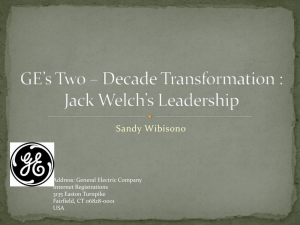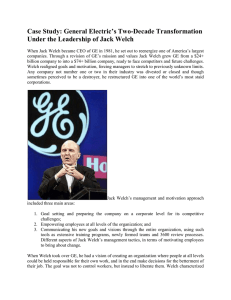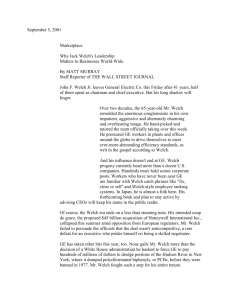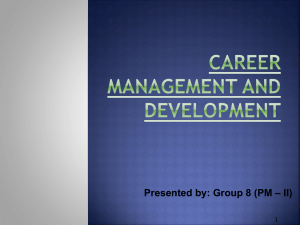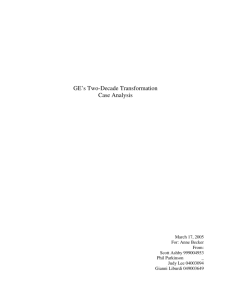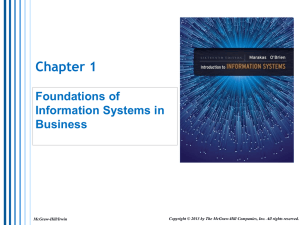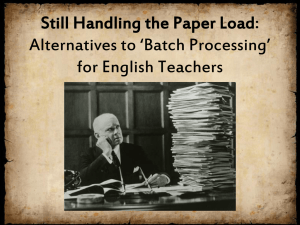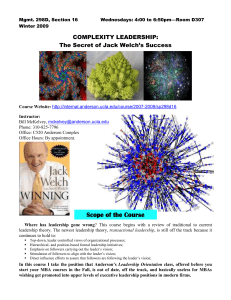GE Two-Decade Transformation: Jack Welch`s Leadership
advertisement
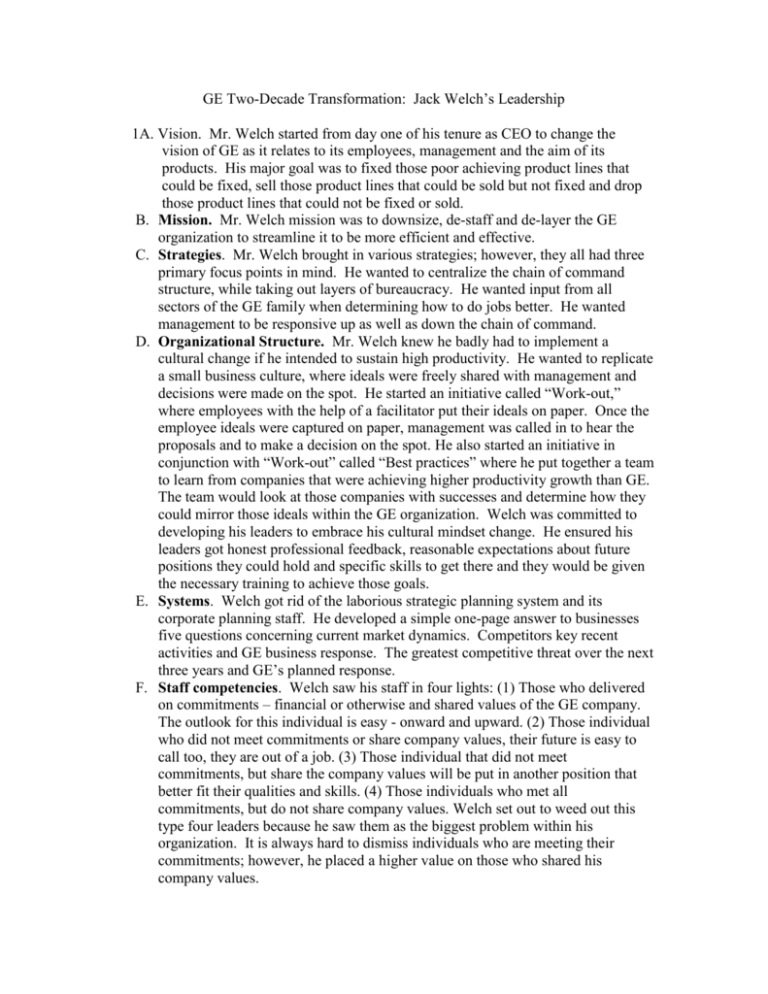
GE Two-Decade Transformation: Jack Welch’s Leadership 1A. Vision. Mr. Welch started from day one of his tenure as CEO to change the vision of GE as it relates to its employees, management and the aim of its products. His major goal was to fixed those poor achieving product lines that could be fixed, sell those product lines that could be sold but not fixed and drop those product lines that could not be fixed or sold. B. Mission. Mr. Welch mission was to downsize, de-staff and de-layer the GE organization to streamline it to be more efficient and effective. C. Strategies. Mr. Welch brought in various strategies; however, they all had three primary focus points in mind. He wanted to centralize the chain of command structure, while taking out layers of bureaucracy. He wanted input from all sectors of the GE family when determining how to do jobs better. He wanted management to be responsive up as well as down the chain of command. D. Organizational Structure. Mr. Welch knew he badly had to implement a cultural change if he intended to sustain high productivity. He wanted to replicate a small business culture, where ideals were freely shared with management and decisions were made on the spot. He started an initiative called “Work-out,” where employees with the help of a facilitator put their ideals on paper. Once the employee ideals were captured on paper, management was called in to hear the proposals and to make a decision on the spot. He also started an initiative in conjunction with “Work-out” called “Best practices” where he put together a team to learn from companies that were achieving higher productivity growth than GE. The team would look at those companies with successes and determine how they could mirror those ideals within the GE organization. Welch was committed to developing his leaders to embrace his cultural mindset change. He ensured his leaders got honest professional feedback, reasonable expectations about future positions they could hold and specific skills to get there and they would be given the necessary training to achieve those goals. E. Systems. Welch got rid of the laborious strategic planning system and its corporate planning staff. He developed a simple one-page answer to businesses five questions concerning current market dynamics. Competitors key recent activities and GE business response. The greatest competitive threat over the next three years and GE’s planned response. F. Staff competencies. Welch saw his staff in four lights: (1) Those who delivered on commitments – financial or otherwise and shared values of the GE company. The outlook for this individual is easy - onward and upward. (2) Those individual who did not meet commitments or share company values, their future is easy to call too, they are out of a job. (3) Those individual that did not meet commitments, but share the company values will be put in another position that better fit their qualities and skills. (4) Those individuals who met all commitments, but do not share company values. Welch set out to weed out this type four leaders because he saw them as the biggest problem within his organization. It is always hard to dismiss individuals who are meeting their commitments; however, he placed a higher value on those who shared his company values. G. Staffing and Staffing development. Welch wanted to ensure that his staff understood the culture he wanted implemented at GE. He provided for the necessary training to help his staff members develop into the leaders and employees he felt GE needed to survive and maintain productivity. H. Leadership style. Welch put in place processes that challenged leadership against the status quo and pushed them to think outside the box. Welch initiative “Work-out” challenged leaders to listen to employees ideals and mandated that they act upon them with a yes or no vote on the spot with their immediate boss listening in to the dialogue. I. Corporate Culture. Welch set out to change corporate culture from the very beginning he took over as CEO of GE. He set out to instill loyalty and honest dialogue up and down the chain of command. He wanted employees to feel like they were working at a small business when it came down to getting their ideals discussed with management for immediate decisions. 2. GE transformation brought about a leaner and more efficient company that enhanced its productivity. GE product earnings subsequently rose and provided all stakeholders with financial gains. 3. GE transformation brought about numerous layoffs initially and uncertainty within its remaining employees and management. During Welch’s initial CEO tenure GE products not performing were cut, which caused company instability. 4. Since Jack Welch retired, 9/11 occurred, GE stock slipped and the new CEO of the company had to deal with Jack Welch oversized footsteps to follow-in. The 9/11 terrorist attacks had a major effect on all businesses, GE included. These mentioned events had a negative impact on GE ability to continue its transformation evolutions, because GE had to deal with shrinking stocks and downward productivity to regain shareholders confidence. These items were of the utmost importance to take care of and transformation was put at a lower priority for the company. 5. GE’s greatest challenge in the future will be to sustain Welch’s energy and transformation efforts. New leadership will be torn between buying into Welch ideals or changing course and having company fail and blame management for not leading as Welch would have led. Welch was a pioneer and his footsteps will be hard for any new CEO to follow. The culture of GE is a culture that Jack Welch built after 20 years of hard work and dedicated effort. Will the new CEO set out to build a new corporate culture or set out to reinvent GE’s culture?

